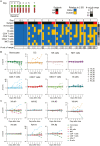Impact on in-depth immunophenotyping of delay to peripheral blood processing
- PMID: 38693758
- PMCID: PMC11239563
- DOI: 10.1093/cei/uxae041
Impact on in-depth immunophenotyping of delay to peripheral blood processing
Abstract
Peripheral blood mononuclear cell (PBMC) immunophenotyping is crucial in tracking activation, disease state, and response to therapy in human subjects. Many studies require the shipping of blood from clinical sites to a laboratory for processing to PBMC, which can lead to delays that impact sample quality. We used an extensive cytometry by time-of-flight (CyTOF) immunophenotyping panel to analyze the impacts of delays to processing and distinct storage conditions on cell composition and quality of PBMC from seven adults across a range of ages, including two with rheumatoid arthritis. Two or more days of delay to processing resulted in extensive red blood cell contamination and increased variability of cell counts. While total memory and naïve B- and T-cell populations were maintained, 4-day delays reduced the frequencies of monocytes. Variation across all immune subsets increased with delays of up to 7 days in processing. Unbiased clustering analysis to define more granular subsets confirmed changes in PBMC composition, including decreases of classical and non-classical monocytes, basophils, plasmacytoid dendritic cells, and follicular helper T cells, with each subset impacted at a distinct time of delay. Expression of activation markers and chemokine receptors changed by Day 2, with differential impacts across subsets and markers. Our data support existing recommendations to process PBMC within 36 h of collection but provide guidance on appropriate immunophenotyping experiments with longer delays.
Keywords: CyTOF; delayed processing; immunophenotyping; monocytes; peripheral blood mononuclear cells.
© The Author(s) 2024. Published by Oxford University Press on behalf of the British Society for Immunology.
Conflict of interest statement
The authors have no conflicts of interest to disclose.
Figures










